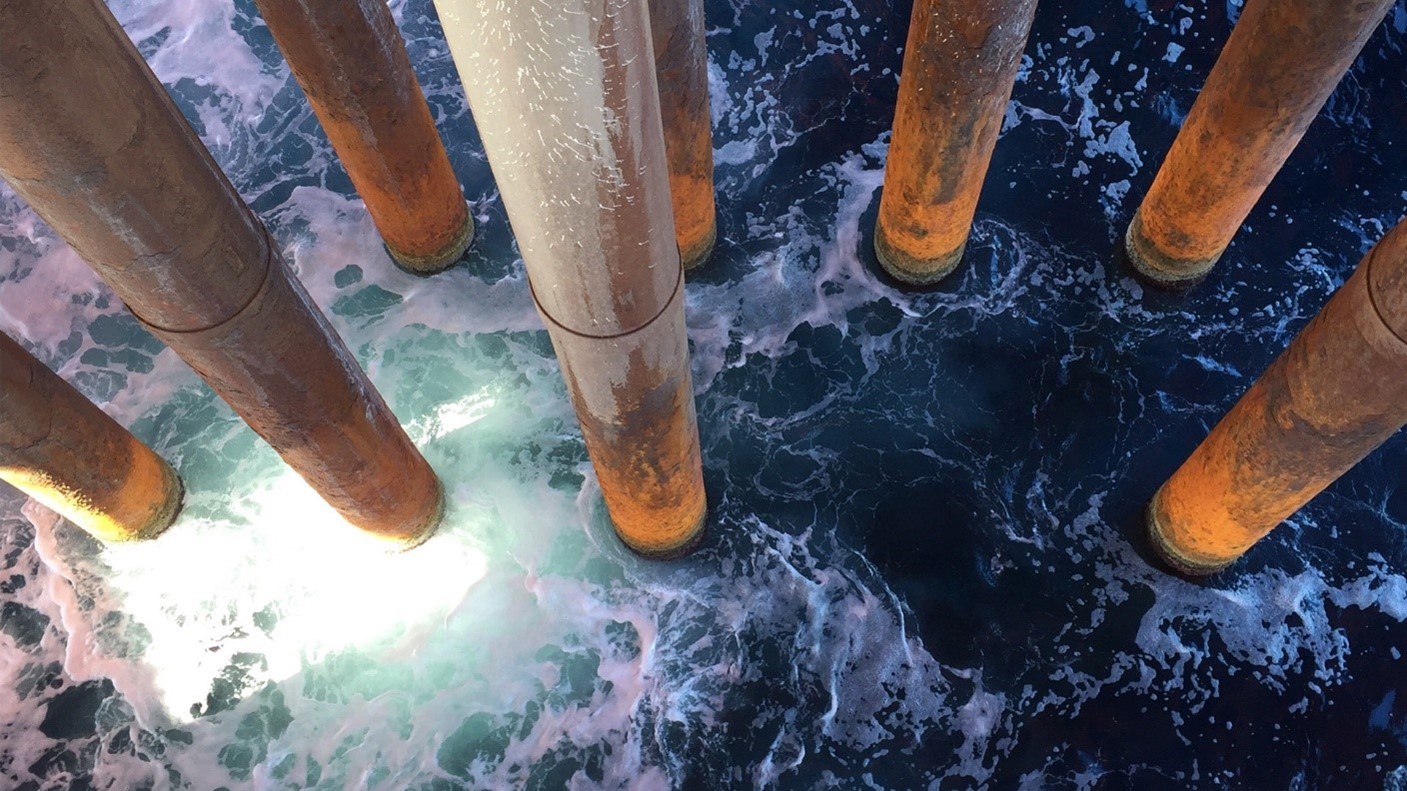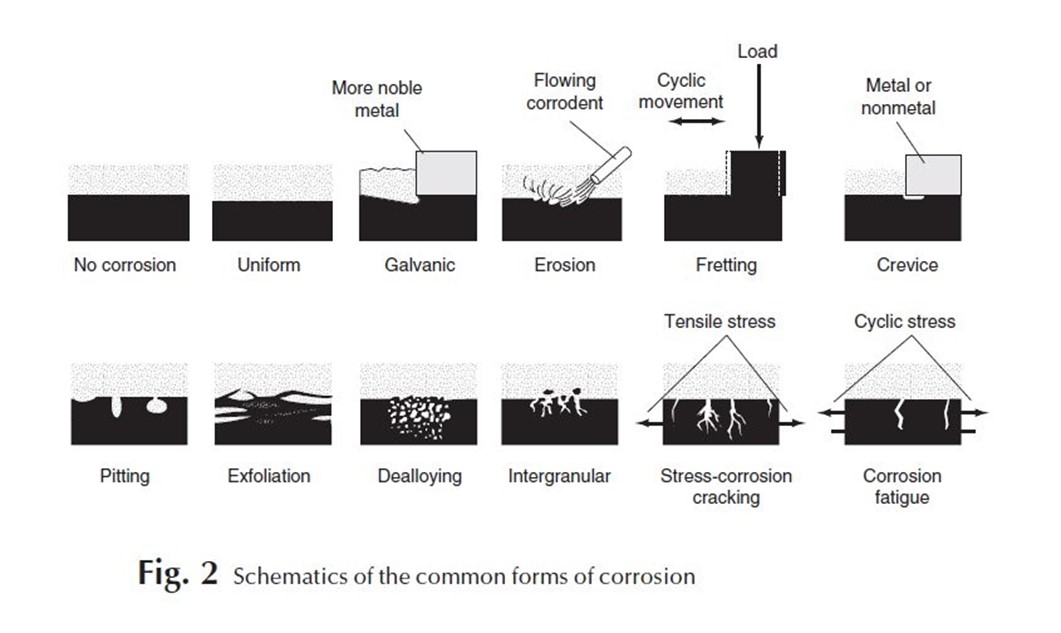Designing with Corrosion in Mind

Corrosion is a critical concern in construction design, as it can significantly impact the longevity, safety and maintenance costs of structures. To set up a project for success, construction professionals should incorporate design principles that consider environmental factors to prevent steel corrosion, which can extend the lifespan of buildings and infrastructure, reduce maintenance costs and enhance safety.
What is Corrosion?
Corrosion is the deterioration of a material, usually a metal, that results from a chemical or electrochemical reaction with its environment (adapted from NACE Corrosion Engineer’s Reference Handbook). When metals like steel are exposed to environmental elements such as moisture, oxygen and pollutants, they can become flaky and brittle, which can negatively impact aesthetic and structural components of buildings and other structures.
 Source: 2000 ASM INTERNATIONAL. CORROSION: UNDERSTANDING THE BASICS (#06691G)
Source: 2000 ASM INTERNATIONAL. CORROSION: UNDERSTANDING THE BASICS (#06691G)
When it comes to steel, the primary corrosion product is rust, which leads to the degradation of materials, causing severe structural damage and deterioration to buildings, bridges, pipelines and other structures. Complex factors impact the corrosion process, but you can implement preventive measures in the design process to impede corrosion.
Why Design Matters When It Comes to Corrosion
Structural engineers, architects and other construction professionals should take a proactive approach to mitigate the effects of corrosion to ensure the durability and integrity of structures over time. Corrosion occurs in three main zones: atmospheric, ground-level and below-ground or subterranean corrosion. These zones do not include all the types of corrosion.
Metallurgical and environmental factors play a key role in determining the rate and extent of corrosion, as they influence the chemical and physical interactions between materials and their surroundings.
Factors that contribute to corrosion:
Metallurgical Factors
- Compositions
- Microstructures
- Inclusions
- Heat treatment
- Mechanical rolling and tempering
- Welding
- Work hardening
Environmental Factors
- Environmental-induced Stress Corrosion Cracking (SCC)
- Sulfide Stress Cracking (SSC)
- Hydrogen-induced cracking (HIC)
- Microbial-induced corrosion (MIC)
- Temperature-induced corrosion (also dry or high-temperature corrosion)
- Mechanical environmental-induced erosion, fretting, or cavitation
- Galvanic, stray current
By prioritizing corrosion prevention, construction professionals can contribute to more sustainable, long-lasting and safe structures. Key considerations in corrosion-conscious design include material selection, protective coatings, design detailing (to avoid moisture traps) and regular maintenance plans.
Estimating Corrosion Factors
By estimating corrosion, you can typically mitigate the troubles caused by corrosion, but always use caution.
Atmospheric Corrosion:
For estimating atmospheric corrosion, the ISO 9223:2012 (Corrosion of metals and alloys) and ISO 9224:2012 (Guiding values for corrosivity) Standards are found to be accurate and widely accepted by corrosion engineers around the world. While the equations and methods are considered very good for uniform atmospheric corrosion, not all corrosion mechanisms can be covered, including localized pitting, galvanic and stress corrosion.
Soil Corrosion:
Unfortunately, a universally accepted approach does not exist for the corrosion rates of steel in soils because different soil types and conditions cause varying corrosion losses. Ongoing qualitative and quantitative studies are underway to determine best practices. Since soil corrosion is highly complicated due to the many factors involved, it is recommended that an AMPP (formerly NACE) certified Corrosion Specialist (corrosion engineer or geo-tech engineer) who is familiar with the location should make the calculations for your intended site.
What to Remember in Corrosion Planning
Proactive planning for corrosion in construction can significantly extend the lifespan of structures and reduce long-term maintenance costs. When you understand the various forms and reactions of corrosion in the atmosphere and soil, you can more effectively protect your equipment and installations against corrosion.
Certain products like paints, epoxies, and other polymers act as a barrier to electrolytes, which can be very effective in certain environments. For example, the application of Zinc, hot dip or continuous galvanizing utilizes the natural sacrificial anodic protection of the metal, which can greatly extend lifetimes in most environments but is also limited in some very severe environments.
Nothing is failproof or permanent in the face of corrosion, so plan accordingly.
For all projects, Nucor supports these standards:
- ASTM, American Society for Testing and Materials
- AISI, American Iron and Steel Institute
- AGA, American Galvanizers Association
- ISO, International Standards Organization
- IATF, International Automotive Task Force
- UL, Underwriters Laboratories, Various committees including the UL 2703 committee on corrosion
If you’d like to design with corrosion in mind for your next project, contact the Nucor Construction Solutions Team.